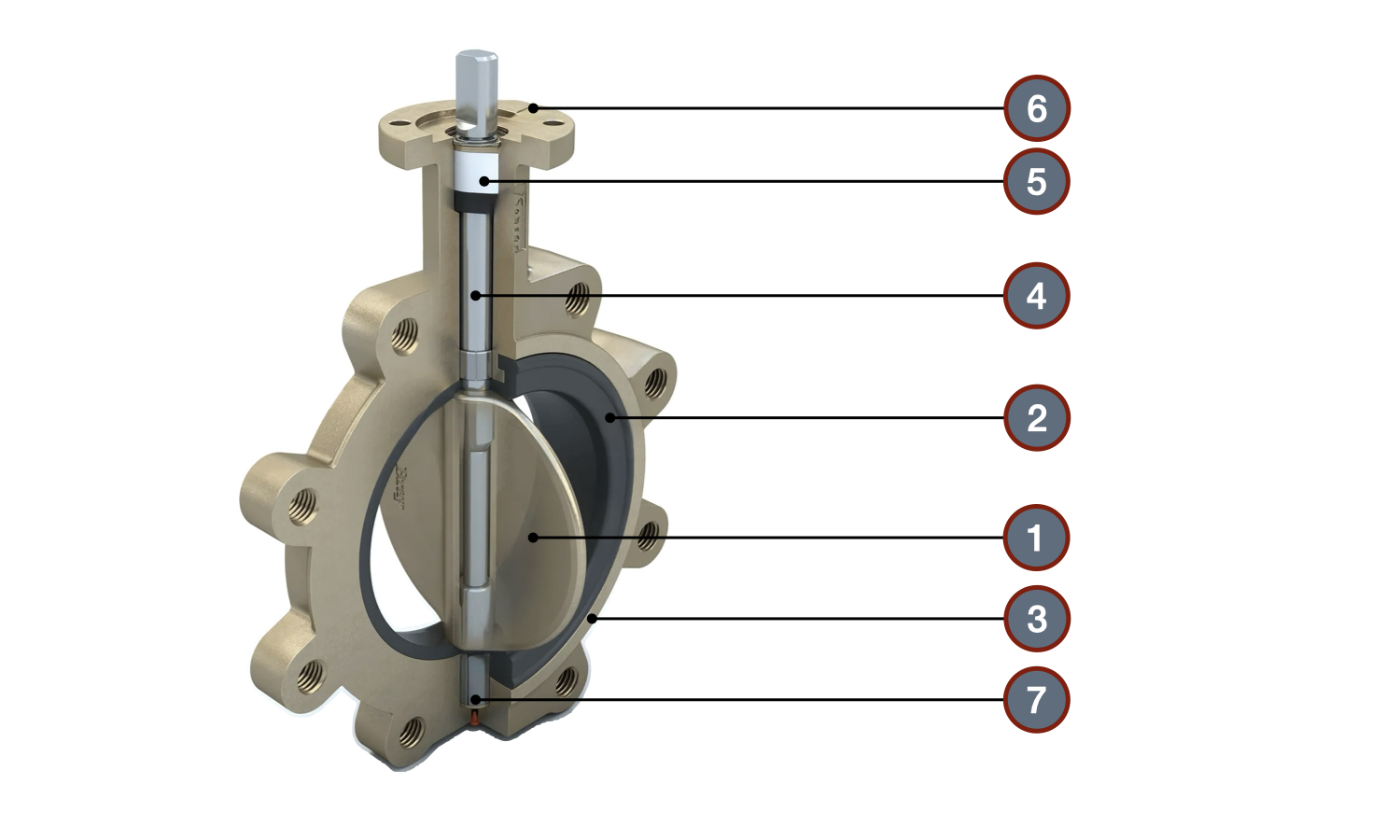Please do not block ads on our site. Clicks on ads help us exist, grow and become more useful for you!
Butterfly valve design
- 1 - Shut-off disc
- 2 - Elastic seal
- 3 - Body
- 4 - Stem
- 5 - Stem seal
- 6 - Actuator mounting flange
- 7 - Stop screw
The design of a butterfly valve consists of a metal disk firmly attached to a rod perpendicular to the axis of the pipeline. Turning the rod 90° rotates the disk from a plane perpendicular to the axis of the pipeline to a plane coincident with it.
Since the valve element is located in the center of the flow and is subjected to the dynamic pressure of the working medium in the open position, a toothed lock is provided on the control handle in the design of the butterfly valve, which is designed to lock the position of the valve element (disk).
The butterfly valve body for flange mounting is made with centering or threaded slots or without them at all. Butterfly valves of large diameter are produced in flanged and welded versions. The valve body usually has an integral design, although some manufacturers produce two-piece bodies.
The butterfly valve is operated by means of a handle, mechanical gear, or electric drive. All butterfly valves that comply with the ISO 5211 directive have standard sizes for connecting control elements and, if necessary, can be equipped with a gearbox or electric drive.
Hand-closing weights are used for butterfly valves with a nominal diameter up to DN150, and for larger sizes, a gearbox or electric drive is used.
Butterfly valves with electric drive are used to automate technological processes and control fittings located in hard-to-reach places. Remember!!! A butterfly valve is a shut-off fitting, so it is not allowed to use them for proportional flow control.
A sleeve made of polymer material is inserted into the flow part of the valve body, which performs three functions at the same time:
- sealing between the flanges and the valve body
- corrosion protection (working medium does not come into contact with the metal of the valve body)
- reduction of the resistance coefficient of the valve
Depending on the temperature regime of operation and the properties of the working environment, gaskets may be made from various polymer materials.
EPDM - ethylene propylene diene monomer - Limit range [from -20 to 130°C], working range [from 4 to 110°C], used for drinking and seawater, cold and hot water, dry air free from oil, alcohols, alkalis, (mineral and organic) acids, salt acids, and sodium hydroxide. Resistant to aging, ozone, and atmospheric effects. Not suitable for use with hydrocarbons.
EPDM heat - heat-resistant ethylene propylene diene monomer - Limit range [from -30 to 150°C], working range [from -15 to 130°C], used for drinking and seawater, cold and hot water, dry air free from oil, alcohols, alkalis, (mineral and organic) acids, salt acids, and sodium hydroxide.
Hypalon - chlorosulfonated polyethylene - Limit range [from -20 to 110°C], working range [from 4 to 80°C], used for mineral acids, oxidizing solutions, alcohols, animal and vegetable oils, and phosphoric acid.
FPM - fluoroelastomer - Limit range [from -20 to 200°C], working range [from -10 to 170°C], used for acids, oils, hydrocarbon mixtures, but not for water, steam, organic acids, and brake fluids. It is characterized by high temperature stability, chemical resistance, resistance to aging, ultraviolet radiation, and aggressive chemical compounds.
VMQ/MVQ - silicone rubber - Limit range [from -40 to 200°C], working range [from -20 to 170°C], used in the food industry, characterized by high resistance to high and low temperatures, oxygen, oils, alcohols, and water. Use with acids, alkalis, and water vapor is not allowed.
NBR - nitrile rubber - Limit range [from -20 to 90°C], working range [from -20 to 100°C], used for oil and gas products, as well as for hot water, steam, and alkaline solutions. Resistant to aging, hydraulic fluids, and lubricants.
PTFE - polytetrafluoroethylene - Teflon - fluoroplastic - Temperature range [from -20 to 200°C], working range [from 4 to 170°C], used for cold and hot water, any aggressive environments, characterized by high resistance to high and low temperatures, without losing elasticity even at critical parameters.
Class A tightness is achieved only in valves with polymer inserts; in the case of sealing with a metal (valve)/metal (body) type, the tightness class is no more than B. For more information on tightness classes, refer to the section on Technical Characteristics.
question : comment : feedback
330
 Catalog of
Catalog of butterfly valves
Genebre
Genebre
Genebre
Zetkama
IVR
IVR
CMO
CMO
Herz
Herz
Danfoss
Danfoss
Ayvaz
EBRO Armaturen
EBRO Armaturen
Belven
Belven
Bray
Valpres
Valpres
ARI Armaturen
ARI Armaturen
ARI Armaturen
ARI Armaturen
Oventrop
Oventrop
ABO VALVE
Ukspar
Brandoni
Brandoni
FAF
FAF
Polix
Polix
Danfoss
IMI Hydronic
Honeywell - Resideo
Маршал
Breeze
Bray
AVK
AVK








 EN 1092-1
EN 1092-1
